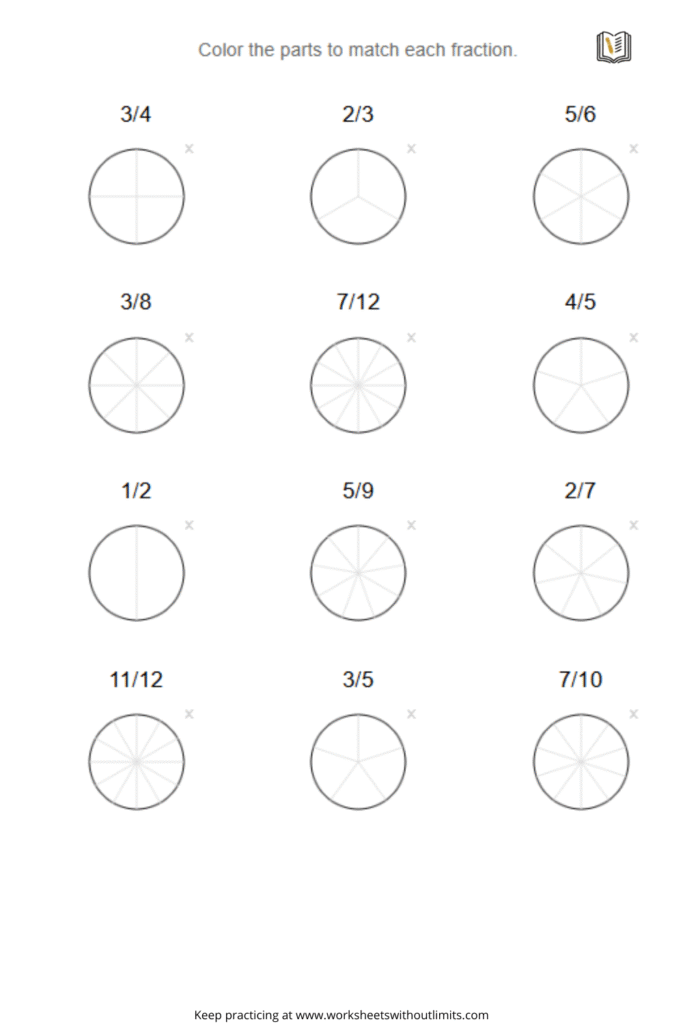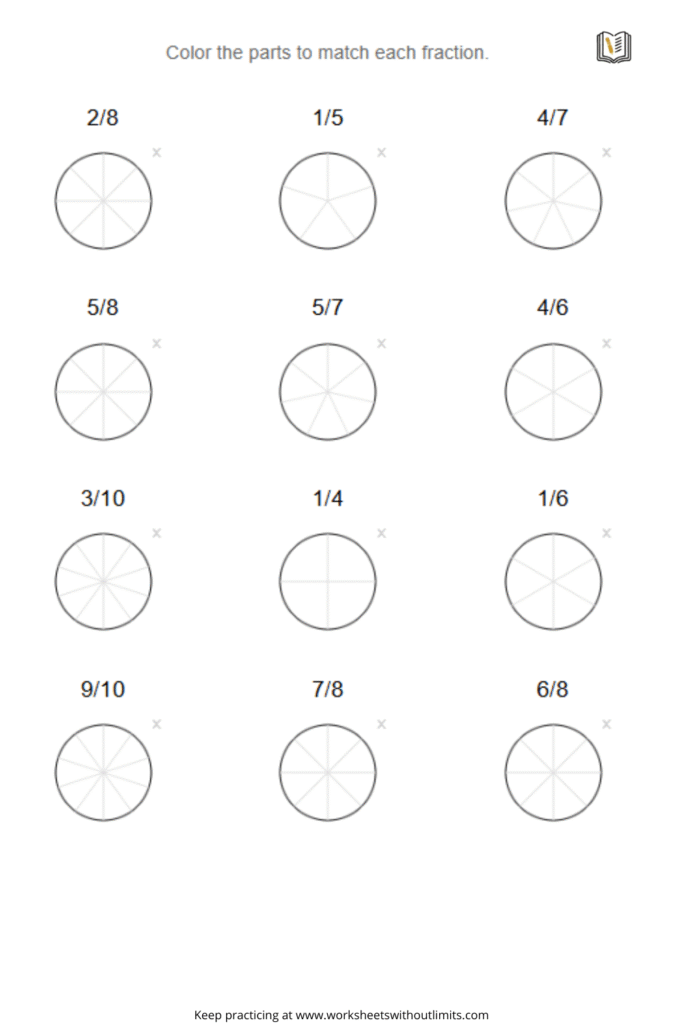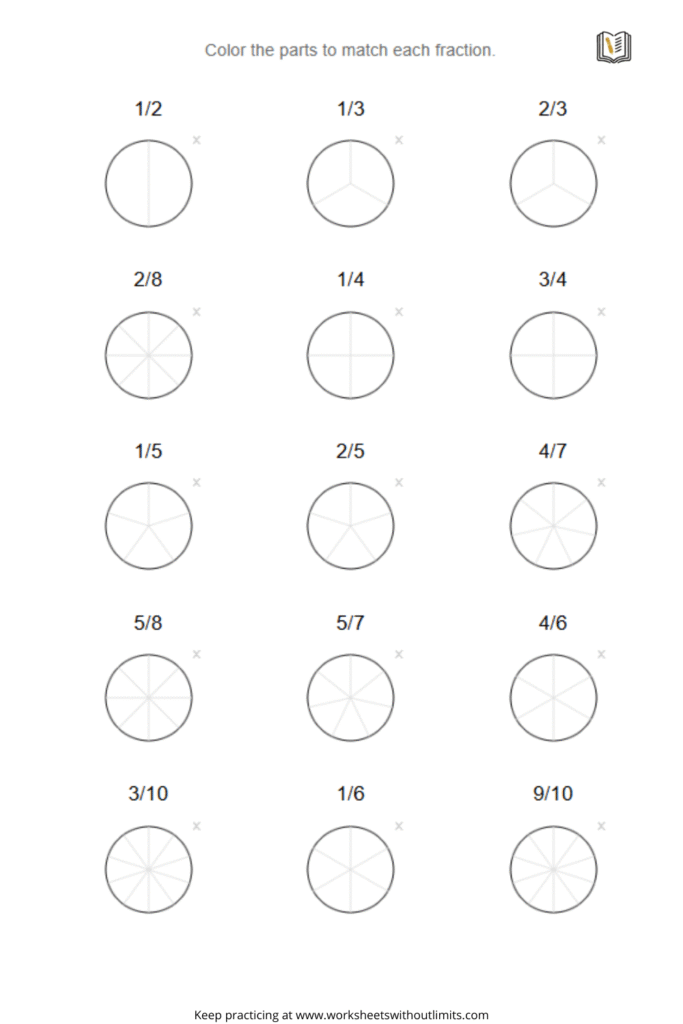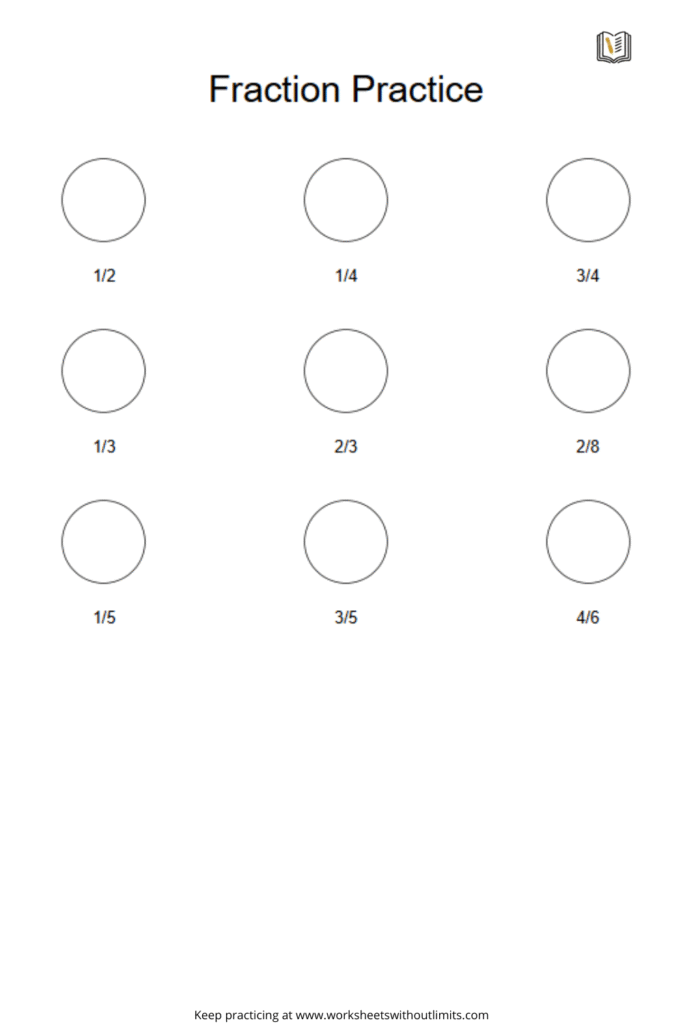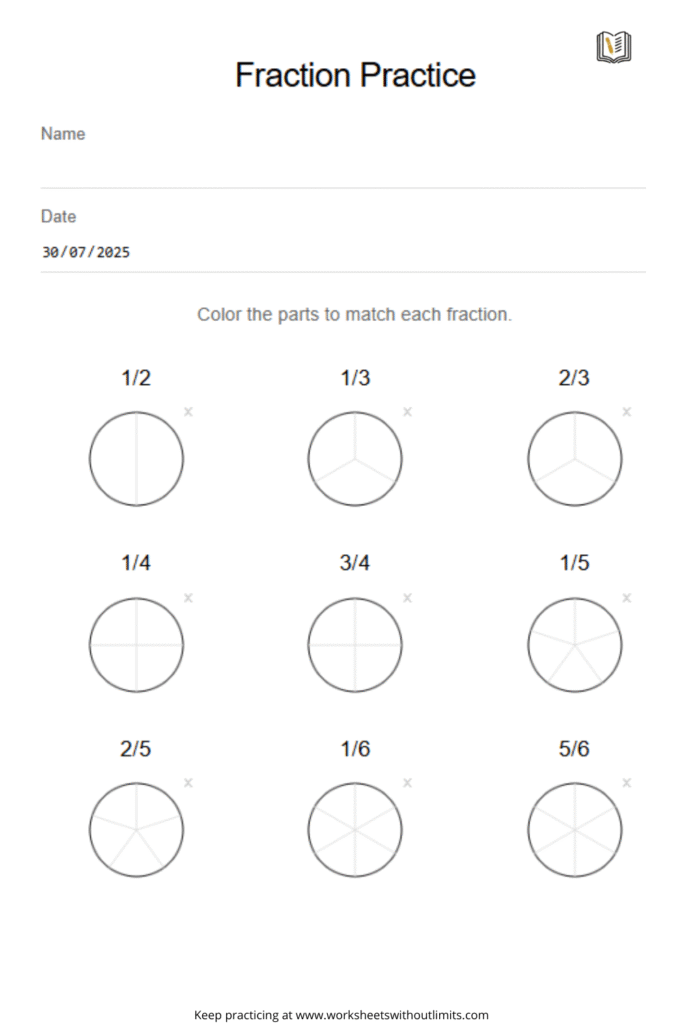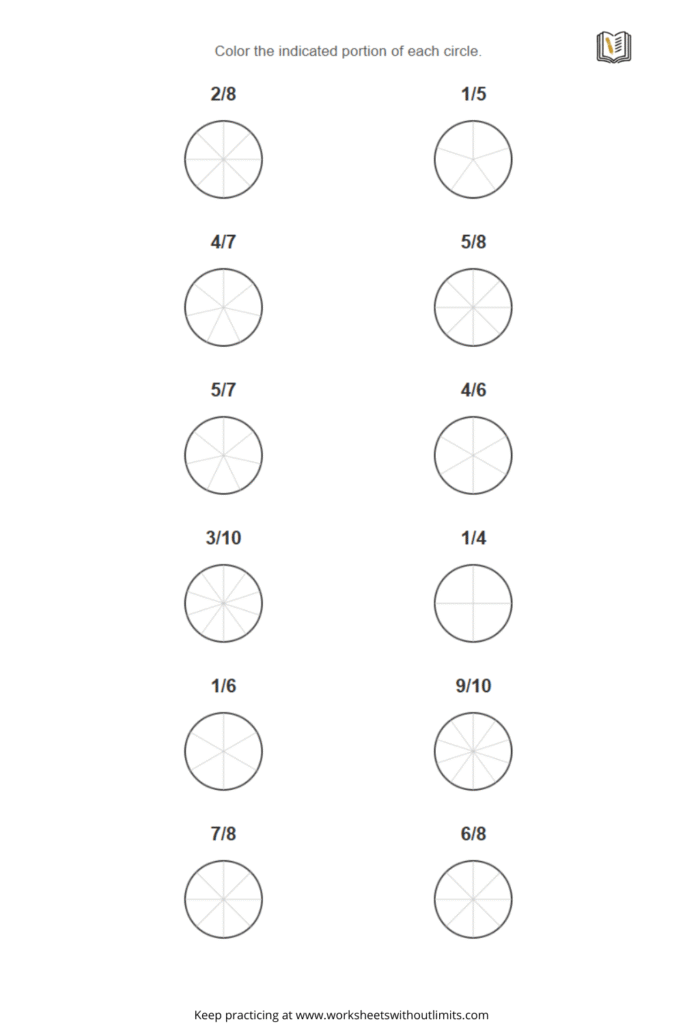For 1st graders, understanding fractions is an important milestone in their early math education. Fractions are the building blocks for many future mathematical concepts, from division and multiplication to understanding ratios and percentages. Offering unlimited fraction exercises is a great way to ensure that students get enough practice to truly grasp the concept of fractions. Whether you’re a teacher looking for resources for your classroom or a parent helping your child at home, this page provides the tools needed to reinforce fraction concepts with interactive, downloadable worksheets.
Fraction Exercises
Level: 1
Identify simple fractions in figures
Progress Analysis
You haven't completed any exercises yet. Start solving to see your progress!
What Are Fractions for 1st Graders?
Fractions are numbers that represent a part of a whole. For 1st graders, the focus is on understanding the basics, such as how to divide objects into equal parts and recognizing simple fractions like 1/2, 1/3, and 1/4. For example, if you have a pizza divided into 4 equal slices, each slice represents 1/4 of the pizza. This type of learning helps young students visualize fractions in a concrete way before they tackle more abstract concepts later on.
By practicing with unlimited fraction exercises, students can better understand how to break down a whole into parts and how these parts relate to each other. These exercises are designed to be interactive and engaging, allowing students to visualize the fractions they are working with and deepen their understanding.
The Importance of Unlimited Fraction Exercises for 1st Graders
Building a Strong Foundation in Math
Introducing fractions to 1st graders with unlimited exercises ensures that they master the basics before moving on to more complex topics. Fractions are essential not only for understanding division and ratios but also for topics such as decimals and percentages, which students will encounter in later grades. By providing unlimited practice opportunities, students are more likely to develop a strong foundation in fractions that will support their learning in the years ahead.
Reinforcing Concepts Through Repetition
Repetition is key when learning math. With unlimited fraction exercises, students have the chance to practice as much as they need to feel confident in their understanding. These exercises can range from simple fraction identification to comparing fractions and understanding the concept of halves, thirds, and quarters. The more students practice, the more confident they become, making it easier for them to tackle more advanced fraction problems in the future.
Real-Life Applications of Fractions
Understanding fractions is not just an academic exercise; it has many real-world applications. For example, when sharing food, measuring ingredients in recipes, or even dividing time, fractions come into play. Offering unlimited fraction exercises helps students see the relevance of what they are learning. By practicing with problems that involve real-world scenarios, students can relate the concept of fractions to their everyday experiences.
Encouraging Critical Thinking and Problem-Solving Skills
Fraction exercises require students to use critical thinking and problem-solving skills. For instance, when they are asked to determine what fraction of an object has been shaded or to compare fractions, they must think logically about how the parts relate to the whole. This fosters their ability to analyze problems, identify patterns, and apply strategies to solve them, skills that are essential in mathematics and beyond.
Why Should Kids Study Fractions?
Fractions are introduced early in a child’s education because they are fundamental to understanding the world of numbers. For 1st graders, learning fractions is essential because:
- They Build Conceptual Understanding of Numbers: Fractions teach students that a whole can be divided into smaller, equal parts. This is important because it helps students understand the idea of division, an essential concept for future math learning.
- They Prepare Students for More Complex Math: As students advance in their education, they will need to work with fractions in more complex ways, such as adding, subtracting, multiplying, and dividing fractions. A strong understanding of simple fractions lays the groundwork for mastering these advanced concepts later.
- They Are Relevant to Everyday Life: Fractions are useful in many real-world situations, like sharing items equally, measuring ingredients, or understanding portions. Introducing fractions early ensures that students can apply these concepts in practical ways.
- They Help Students Develop Mathematical Thinking: Learning fractions encourages logical thinking and reasoning. It also improves problem-solving abilities, as students have to break down problems and analyze them in smaller steps to find the solution.
What Should 1st Graders Develop Through Studying Fractions?
In 1st grade, students are expected to understand the following:
- Identifying Fractions: Students should be able to recognize and name basic fractions such as 1/2, 1/3, and 1/4, and understand their meaning. They should be able to identify these fractions in everyday objects and shapes.
- Understanding Equal Parts: The key idea behind fractions is dividing a whole into equal parts. Students should develop the ability to identify when an object is divided into equal parts, such as when a pizza is cut into 4 equal slices, each representing 1/4.
- Comparing Fractions: Students should start comparing fractions to understand the concept of greater than, less than, or equal to. For example, students should be able to understand that 1/2 is greater than 1/4.
- Building Confidence with Math: Fractions can be tricky, but regular practice through unlimited exercises helps students gain confidence. As they continue to practice and improve their fraction skills, they will feel more comfortable with math overall.
Tips for Practicing Fractions for 1st Graders
- Start Simple: Begin with basic fractions such as 1/2 and 1/4, and as students gain confidence, introduce more complex fractions like 1/3. This gradual progression ensures that students build a strong foundation.
- Use Visual Aids: Fraction bars, pie charts, and pictures of divided objects are great tools for helping students visualize fractions. Seeing the fractions in a concrete way makes the concept easier to understand.
- Interactive Exercises: Unlimited fraction exercises are ideal for 1st graders as they allow students to practice at their own pace. These interactive worksheets can help reinforce concepts through engaging and hands-on activities.
- Apply Fractions to Real-Life Situations: Encourage students to think of real-world examples of fractions, such as dividing snacks, sharing toys, or measuring ingredients. This makes learning more meaningful and relatable.
- Make Learning Fun: Turn fraction practice into a fun game! Fraction puzzles, matching games, or interactive online fraction exercises can keep students engaged while learning important math skills.
Unlimited Fraction Worksheets for 1st Graders
Unlimited fraction worksheets are an excellent way to practice and reinforce the concepts of fractions. These worksheets feature various exercises that range from coloring in fractions of objects to comparing different fractions. By offering unlimited exercises, students have the chance to practice and refine their understanding until they feel confident in their skills. The more practice students get, the more they solidify their knowledge and improve their abilities.
Downloadable Educational Sheets for Further Practice
At the bottom of this page, you will find downloadable educational sheets for 1st graders that focus on fractions. These worksheets provide additional exercises for further practice, helping students reinforce what they have learned. Whether you are a parent or a teacher, these resources are invaluable for helping young learners develop a solid understanding of fractions.
These educational sheets can be used in the classroom or at home for extra practice, offering a flexible and effective way for students to master fractions at their own pace.
Find all the educational worksheets on our Pinterest account.

